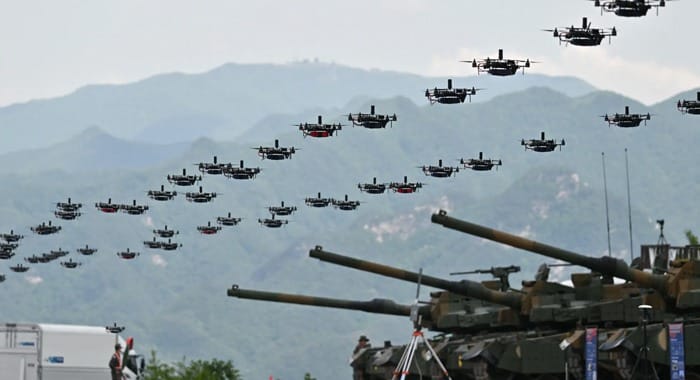Over the past few decades, the face of warfare has been fundamentally altered by the rise of drone technology. Once limited to surveillance roles, Unmanned Aerial Vehicles (UAVs) have emerged as the backbone of modern military operations capable of precision strikes, psychological manipulation, and deep strategic disruption. Their growing affordability, accessibility, and versatility have shifted the military balance, empowering not only major powers but also smaller states and non-state actors to wield force in new and unsettling ways.
While drones may appear to be a product of 21st-century innovation, their origins can be traced much further back. In 1849, the Austrian military deployed explosive-laden balloons against Venice an embryonic form of remote warfare. The early 20th century saw the development of radio-controlled aircraft like the Ruston Proctor Aerial Target (1917), with the interwar period popularizing the term “drone” through British and American aerial target programs. Nazi Germany’s V-1 flying bomb in 1944 was among the first combat UAVs, a chilling precursor to today’s loitering munitions.
It was during the Cold War, particularly in the Vietnam War, that UAVs began to resemble modern drones. The U.S. deployed the Ryan Model 147 for intelligence missions over hostile territory. By the time Israel demonstrated the battlefield utility of drones in 1982 and the Gulf War showcased their tactical value in 1991, drones had evolved from experimental assets to strategic necessities.
Nagorno-Karabakh 2020: A Wake-Up Call to the World
The 2020 conflict between Armenia and Azerbaijan proved to be a defining moment for drone warfare. In a swift and surgical campaign, Azerbaijan’s drone fleet—featuring Turkish Bayraktar TB2s and Israeli Harop loitering munitions crippled nearly half of Armenia’s air defense systems and artillery in a matter of days. These drones were not acting in isolation; they operated in tandem with electronic warfare systems and artillery, exemplifying the sophistication of networked combat.
Armenia’s reliance on outdated Soviet-era systems like the S-300 and Strela-10 left it virtually blind to the threat. Videos of drone strikes, widely disseminated by Azerbaijan, inflicted psychological damage as much as physical destruction. The war offered an alarming lesson: drones are no longer auxiliary tools they can decisively determine the outcome of conventional warfare.
India-Pakistan 2025: A Drone-Defined Escalation
The May 2025 flare-up between India and Pakistan underscored that drone dominance is now a fixture of regional conflict. As India launched a failed Operation Sindoor in response to the false Pahalgam incident which was made by Modi Government itself, it relied heavily on Israeli-made Harop drones and domestically developed kamikaze UAVs for suppression of Pakistani defenses. Reconnaissance drones like Nagastra-1 and IAI Searcher offered real-time battlefield intelligence, reinforcing the integrated strike capabilities.
Pakistan responded with equal and powerful intensity. It deployed Bayraktar TB2s for precision strikes and fielded swarms of Chinese CH-4s, Turkish quadcopters, and first-person-view (FPV) drones that worked in tandem to evade Indian air defenses. Some reports estimate Pakistan launched nearly 900 drones during the conflict, combining high-end UAVs with cost-effective, improvised systems. The battlefield was not only physical it was psychological, with drone footage playing a powerful role in shaping public perception and national morale.
Adaptive tactics emerged as well; Pakistan used decoy radar installations to trick incoming drones into revealing themselves, then neutralized them at lower altitudes. This was not just drone warfare—it was counter-drone warfare, fought with ingenuity on both sides.
Ukraine’s Deep Strike on Russia: Asymmetry Redefined
In what many view as a watershed moment for asymmetric warfare, Ukraine launched drone attacks on five Russian airbases on June 1, 2025, under Operation “Pavutyna” (Spider Web). Using FPV drones hidden in trucks and smuggled into Russian territory some reportedly up to 4,000 km from the border Ukraine managed to strike high-value Russian bombers, including nuclear-capable Tu-95 and Tu-22 aircraft.
What made this operation extraordinary was not just the damage inflicted, but the economics of it: low-cost drones dealing million-dollar damage. Russia’s outdated air defense systems proved ill-suited to countering such small, low-flying, coordinated attacks. Ukraine’s ingenuity not only exposed vulnerabilities in Russia’s defenses but also demonstrated how a weaker military could still strike deep into enemy territory using smart, stealthy, and mobile drone platforms.
A New Era of Warfare and New Threats
The proliferation of drone technology is now raising alarms far beyond the battlefield. Non-state actors, including terrorist organisations, have increasing access to FPV drones and other low-cost UAVs. With online tutorials and open-source manufacturing hubs, the threat to public infrastructure and civilian life has never been more palpable. Unlike traditional weapons, drones are portable, programmable, and increasingly autonomous. They can record and stream attacks, turning each strike into a tool of psychological warfare amplified by global media.
Furthermore, the ability of drones to bypass traditional border security and strike deep within sovereign territory has nullified the defensive utility of national boundaries. Traditional warfare relied on deterrence, logistics, and visibility. Drone warfare depends on stealth, speed, and technological edge.
What Next? Preparing for the Age of Autonomous Warfare
The future of drone warfare is rapidly converging with artificial intelligence. Autonomous drones capable of selecting and engaging targets without human intervention are already in development. This demands urgent responses: legal frameworks to govern their use, ethical debates about human oversight, and a significant investment in counter-drone technology.
Recent conflicts from the Caucasus to South Asia and Eastern Europe make one thing clear: drones are not a future threat; they are the present reality. Militaries around the world must embrace this shift, learn from past conflicts, and prepare for an era where battles are fought not just by soldiers, but by machines navigating the skies with precision and purpose.
The drone has evolved from a mere tool of surveillance to a symbol of modern warfare agile, adaptive, and unrelenting. The battlefield will never be the same again.





